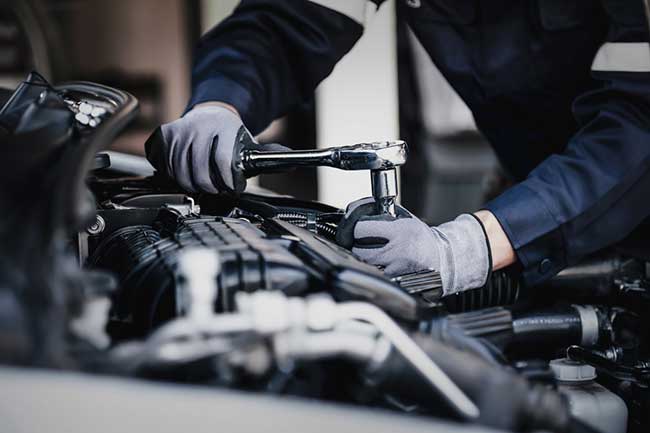All Categories
Featured
Responsible for integrating the turning of the crankshaft and camshaft, the timing belt makes certain the engine's valves open and close at the proper times throughout the burning procedure. If the timing belt fails, it can result in serious engine damage.
What Is a Timing Belt? The timing belt is a long, toothed rubber or composite belt that connects the crankshaft to the camshaft(s) in an interior burning engine. Its job is to maintain the engine's valves and pistons in sync, making sure the engine runs successfully. The timing belt also manages other essential engine features like the water pump and the power steering pump, relying on the lorry.
![]()
Without the correct timing, the engine's pistons and shutoffs can clash, causing pricey and comprehensive damage. Changing the timing belt on schedule is one of the best methods to ensure your engine runs at its best and stop costly repair work.
Why Timing Belt Replacement Issues. Stopping Catastrophic Engine Damage: The most significant danger of not replacing a used timing belt is engine failure. Replacing the timing belt at the suggested intervals is the best means to avoid such devastating damages, saving you from the tension and high expense of engine repairs or replacement.
![]()
Keeping Engine Effectiveness: A timing belt that's in great problem ensures that all engine components work in best consistency. If the timing belt is used or stretched, it can create the engine to lose power, experience rough idling, or battle to begin. By replacing the timing belt regularly, you can maintain your engine going for peak efficiency, which aids keep optimal gas economic climate and performance.
Avoiding Unexpected Failures: A damaged timing belt can create your engine to stop quickly, potentially leaving you stranded in the middle of a journey. By replacing your timing belt in a timely manner, you lessen the threat of abrupt break downs that could leave you in a troublesome or risky scenario. Regular upkeep minimizes the opportunities of experiencing these kinds of disruptions, aiding you remain on the road longer without fretting about your engine failing.
Cost-efficient Upkeep: Timing belt replacement is much more economical than repairing or replacing an engine that's been damaged due to a timing belt failure. While the expense of changing the timing belt might vary relying on your lorry and its place, it is far much more economical than the costs connected with major engine repair work or substitutes. Changing your timing belt at the suggested periods can save you a considerable quantity of money over the future by stopping damages to your engine.
When Should You Replace Your Timing Belt? The timing belt does not last permanently, and the majority of producers advise changing it in between 60,000 and 100,000 miles. Nonetheless, the precise timing depends on your car's make, model, and driving problems, so it's vital to check your proprietor's guidebook for certain support.
Indications that your timing belt may require focus consist of uncommon engine sounds (such as a high-pitched whining or ticking audio), difficulty beginning the engine, or a decrease in engine efficiency. If you notice any one of these signs, it's important to have the timing belt evaluated by an expert technician.
![]()
Conclusion. The timing belt is a crucial however tiny element of your engine, and routine substitute is crucial to maintaining your automobile's efficiency and avoiding expensive damage. By staying on top of timing belt upkeep, you'll ensure your engine operates successfully, stay clear of unanticipated failures, and shield your vehicle from major repair work. Watch on your vehicle's advised timing belt substitute schedule, and constantly speak with a trusted technician to maintain your engine running efficiently for many years to come.
What Is a Timing Belt? The timing belt is a long, toothed rubber or composite belt that connects the crankshaft to the camshaft(s) in an interior burning engine. Its job is to maintain the engine's valves and pistons in sync, making sure the engine runs successfully. The timing belt also manages other essential engine features like the water pump and the power steering pump, relying on the lorry.

Without the correct timing, the engine's pistons and shutoffs can clash, causing pricey and comprehensive damage. Changing the timing belt on schedule is one of the best methods to ensure your engine runs at its best and stop costly repair work.
Why Timing Belt Replacement Issues. Stopping Catastrophic Engine Damage: The most significant danger of not replacing a used timing belt is engine failure. Replacing the timing belt at the suggested intervals is the best means to avoid such devastating damages, saving you from the tension and high expense of engine repairs or replacement.

Keeping Engine Effectiveness: A timing belt that's in great problem ensures that all engine components work in best consistency. If the timing belt is used or stretched, it can create the engine to lose power, experience rough idling, or battle to begin. By replacing the timing belt regularly, you can maintain your engine going for peak efficiency, which aids keep optimal gas economic climate and performance.
Avoiding Unexpected Failures: A damaged timing belt can create your engine to stop quickly, potentially leaving you stranded in the middle of a journey. By replacing your timing belt in a timely manner, you lessen the threat of abrupt break downs that could leave you in a troublesome or risky scenario. Regular upkeep minimizes the opportunities of experiencing these kinds of disruptions, aiding you remain on the road longer without fretting about your engine failing.
Cost-efficient Upkeep: Timing belt replacement is much more economical than repairing or replacing an engine that's been damaged due to a timing belt failure. While the expense of changing the timing belt might vary relying on your lorry and its place, it is far much more economical than the costs connected with major engine repair work or substitutes. Changing your timing belt at the suggested periods can save you a considerable quantity of money over the future by stopping damages to your engine.
When Should You Replace Your Timing Belt? The timing belt does not last permanently, and the majority of producers advise changing it in between 60,000 and 100,000 miles. Nonetheless, the precise timing depends on your car's make, model, and driving problems, so it's vital to check your proprietor's guidebook for certain support.
Indications that your timing belt may require focus consist of uncommon engine sounds (such as a high-pitched whining or ticking audio), difficulty beginning the engine, or a decrease in engine efficiency. If you notice any one of these signs, it's important to have the timing belt evaluated by an expert technician.

Conclusion. The timing belt is a crucial however tiny element of your engine, and routine substitute is crucial to maintaining your automobile's efficiency and avoiding expensive damage. By staying on top of timing belt upkeep, you'll ensure your engine operates successfully, stay clear of unanticipated failures, and shield your vehicle from major repair work. Watch on your vehicle's advised timing belt substitute schedule, and constantly speak with a trusted technician to maintain your engine running efficiently for many years to come.
Latest Posts
Find Brake Repair & More: Full Repair Options from Montclare Auto Repair
Published May 27, 25
1 min read
Reasons Routine Vehicle Maintenance at Montclare Auto Repair Reduces Costs
Published May 27, 25
1 min read
Discover Oil Changes & More: Full Auto Care Solutions from Montclare Auto Repair
Published May 26, 25
1 min read
More
Latest Posts
Find Brake Repair & More: Full Repair Options from Montclare Auto Repair
Published May 27, 25
1 min read
Reasons Routine Vehicle Maintenance at Montclare Auto Repair Reduces Costs
Published May 27, 25
1 min read
Discover Oil Changes & More: Full Auto Care Solutions from Montclare Auto Repair
Published May 26, 25
1 min read